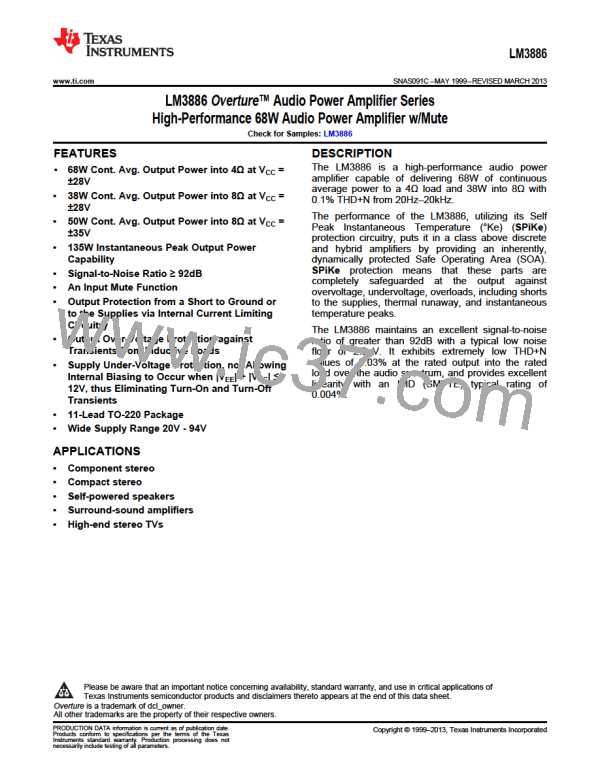LM3886
www.ti.com
SNAS091C –MAY 1999–REVISED MARCH 2013
The DC thermal resistance applies when one output transistor is operating continuously. The AC thermal
resistance applies with the output transistors conducting alternately at a high enough frequency that the
peak capability of neither transistor is exceeded.
Power Bandwidth: The power bandwidth of an audio amplifier is the frequency range over which the amplifier
voltage gain does not fall below 0.707 of the flat band voltage gain specified for a given load and output
power.
Power bandwidth also can be measured by the frequencies at which a specified level of distortion is
obtained while the amplifier delivers a power output 3 dB below the rated output. For example, an
amplifier rated at 60W with ≤ 0.25% THD + N, would make its power bandwidth measured as the
difference between the upper and lower frequencies at which 0.25% distortion was obtained while the
amplifier was delivering 30W.
Gain-Bandwidth Product: The Gain-Bandwidth Product is a way of predicting the high-frequency usefulness of
an op amp. The Gain-Bandwidth Product is sometimes called the unity-gain frequency or unity-gain cross
frequency because the open-loop gain characteristic passes through or crosses unity gain at this
frequency. Simply, we have the following relationship: ACL1 × f1 = ACL2 × f2
Assuming that at unity-gain (ACL1 = 1 or (0 dB)) fu = fi = GBWP, then we have the following: GBWP = ACL2
× f2
This says that once fu (GBWP) is known for an amplifier, then the open-loop gain can be found at any
frequency. This is also an excellent equation to determine the 3 dB point of a closed-loop gain, assuming
that you know the GBWP of the device. Refer to Figure 52.
Biamplification: The technique of splitting the audio frequency spectrum into two sections and using individual
power amplifiers to drive a separate woofer and tweeter. Crossover frequencies for the amplifiers usually
vary between 500 Hz and 1600 Hz. “Biamping” has the advantages of allowing smaller power amps to
produce a given sound pressure level and reducing distortion effects produced by overdrive in one part of
the frequency spectrum affecting the other part.
C.C.I.R./A.R.M.: Literally: International Radio Consultative Committee/Average Responding Meter
This refers to a weighted noise measurement for a Dolby B type noise reduction system. A filter
characteristic is used that gives a closer correlation of the measurement with the subjective annoyance of
noise to the ear. Measurements made with this filter cannot necessarily be related to unweighted noise
measurements by some fixed conversion factor since the answers obtained will depend on the spectrum
of the noise source.
S.P.L.: Sound Pressure Level—usually measured with a microphone/meter combination calibrated to a pressure
level of 0.0002 μBars (approximately the threshold hearing level).
S.P.L. = 20 Log 10P/0.0002 dB
where P is the R.M.S. sound pressure in microbars. (1 Bar = 1 atmosphere = 14.5 lb/in2 = 194 dB S.P.L.).
Figure 52.
Copyright © 1999–2013, Texas Instruments Incorporated
Submit Documentation Feedback
25
Product Folder Links: LM3886

 TI [ TEXAS INSTRUMENTS ]
TI [ TEXAS INSTRUMENTS ]